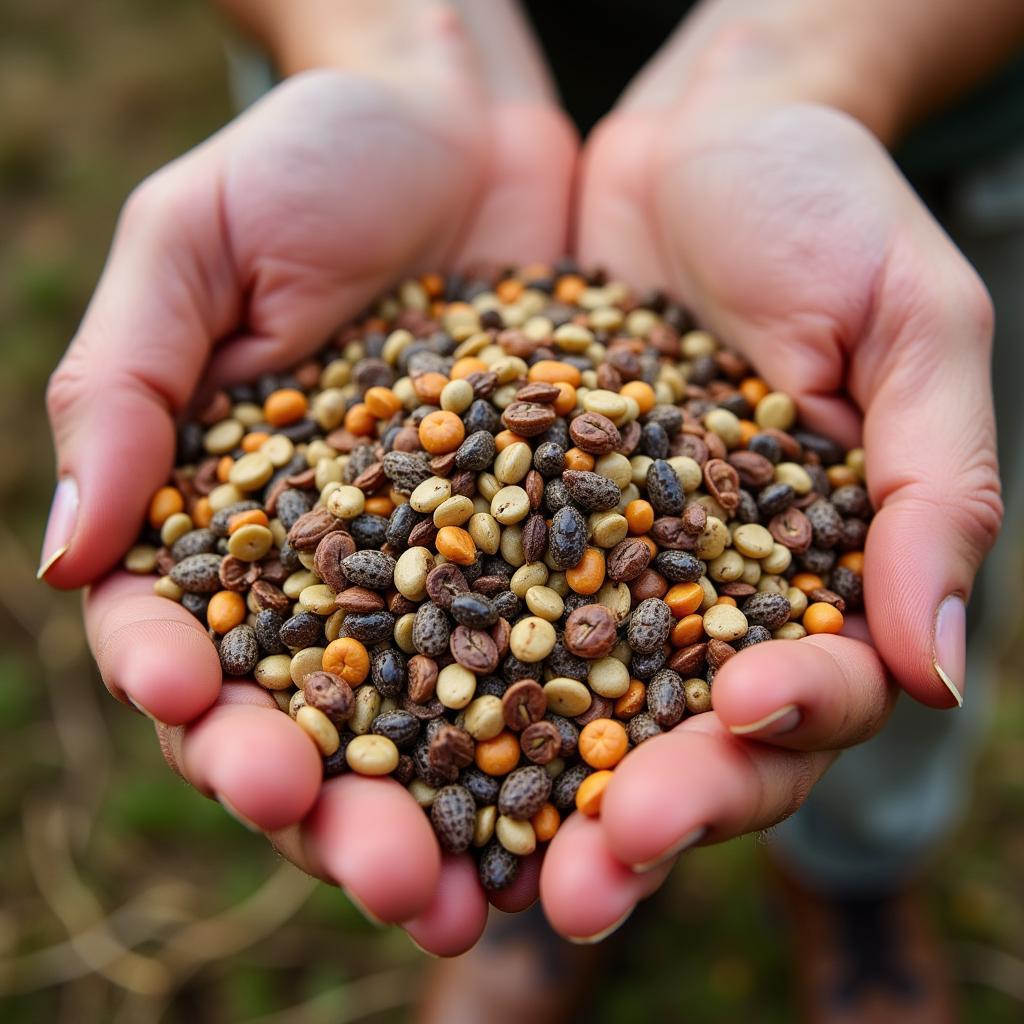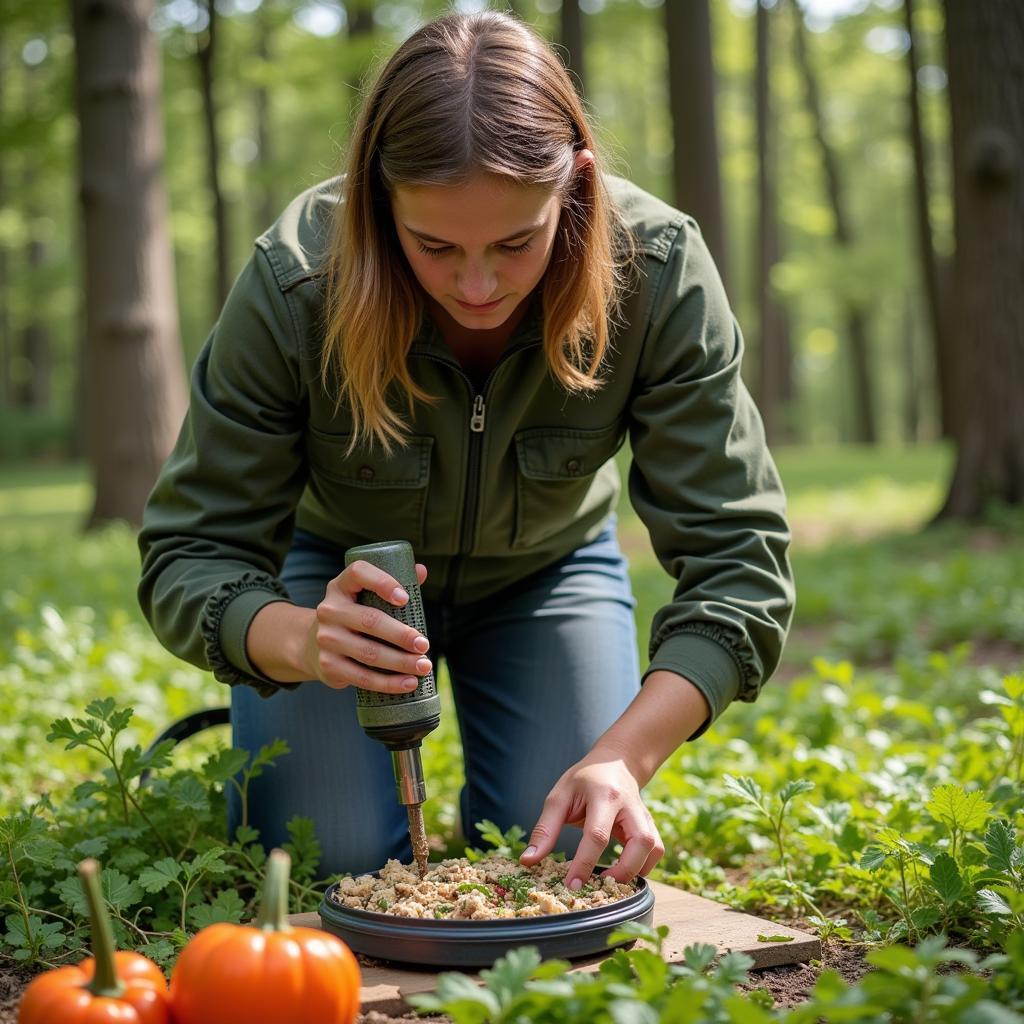Fall Food Plot Mixtures are the key to attracting deer to your hunting grounds and ensuring a successful hunting season. As the temperatures cool down and natural food sources become scarce, a well-planned food plot can provide a vital lifeline for deer, keeping them healthy and coming back for more. But with so many seed options available, choosing the right fall food plot mixture can be a daunting task. Fear not, fellow hunters! This guide will equip you with the knowledge and insights needed to create a thriving food plot that will have deer lining up for a taste.
Understanding the Importance of Fall Food Plots
 Deer Grazing in a Lush Fall Food Plot
Deer Grazing in a Lush Fall Food Plot
Before we dive into specific seed mixtures, it’s crucial to understand why fall food plots are so important for deer. During the spring and summer months, deer have an abundance of natural food sources to choose from. However, as summer fades into fall, these natural foods begin to dwindle, leaving deer with limited options. This is where your strategically planned food plot comes in! By providing a reliable source of nutritious forage during the fall, you’re not only helping deer survive the lean months but also attracting them to your hunting area and increasing your chances of a successful hunt.
Choosing the Right Fall Food Plot Mixture
 Close-up of Fall Food Plot Seed Mix
Close-up of Fall Food Plot Seed Mix
The key to a successful fall food plot lies in selecting the right seed mixture. Here are some popular and effective options:
1. Cereal Grains: Cereal grains, such as oats, winter wheat, and rye, are cold-hardy and provide deer with essential carbohydrates for energy during the colder months. They establish quickly and can tolerate a range of soil conditions, making them a versatile choice for fall food plots.
2. Brassicas: Brassicas, including turnips, radishes, and rape, are highly palatable to deer and offer a nutritional powerhouse of vitamins and minerals. These cool-season crops thrive in the fall and provide deer with valuable forage during the late season.
3. Legumes: Legumes, such as clovers and alfalfa, are an excellent source of protein, which is essential for antler growth and overall deer health. While they might take longer to establish than cereal grains, legumes offer long-term benefits for your food plot.
4. Pre-Mixed Blends: Don’t feel overwhelmed by the options! Many retailers offer food plot mixes specifically formulated for fall planting. These blends often combine cereal grains, brassicas, and legumes to provide a well-rounded nutritional profile for deer.
Factors to Consider When Choosing Your Mixture
While the seed types mentioned above are all excellent choices for fall food plots, the ideal mixture for your specific location will depend on several factors:
-
Soil Type and pH: Different plants thrive in different soil conditions. Conduct a soil test to determine your soil type and pH level, and choose seed varieties that are well-suited to your soil.
-
Climate and Growing Season: Consider your local climate and the length of your growing season. Some plants, like winter wheat, are more cold-tolerant than others.
-
Deer Density and Browsing Pressure: The size of your deer herd and the browsing pressure in your area will influence the amount of seed you need and the type of plants that will thrive.
-
Budget: Food plot seed costs can vary depending on the seed type and blend. Determine your budget and choose seed options that fit within your financial constraints.
Planting and Maintaining Your Fall Food Plot
 Preparing a Food Plot for Planting(https://minacones.com/food-plot-drill/) to prepare the soil for planting a fall food plot. The image emphasizes the importance of proper soil preparation for successful food plot establishment.]
Preparing a Food Plot for Planting(https://minacones.com/food-plot-drill/) to prepare the soil for planting a fall food plot. The image emphasizes the importance of proper soil preparation for successful food plot establishment.]
Once you’ve chosen your ideal fall food plot mixture, it’s time to get planting! Here’s a step-by-step guide to ensure a successful outcome:
-
Soil Preparation: Proper soil preparation is crucial for seed germination and plant growth. Clear any existing vegetation, till the soil to a depth of 6-8 inches, and remove any rocks or debris.
-
Soil Testing and Amendment: Conduct a soil test to determine the pH level and nutrient content of your soil. Amend the soil based on the test recommendations to create an optimal growing environment for your chosen seed mixture.
-
Planting Time: The ideal planting time for fall food plots varies depending on your location and climate. Consult with your local agricultural extension office or seed supplier for specific planting dates in your area.
-
Seeding Rate: Follow the recommended seeding rate on the seed package. Over-seeding can lead to competition for resources, while under-seeding can result in a sparse food plot.
-
Fertilization: Fertilize your food plot based on the soil test recommendations and the needs of your chosen plant species.
-
Weed Control: Implement weed control measures to prevent competition for nutrients and sunlight. This might involve pre-emergent herbicides, hand-weeding, or a combination of both.
-
Maintenance: Regularly monitor your food plot for signs of pests or diseases, and take appropriate action if necessary.
Expert Insights: Maximizing Your Food Plot’s Potential
“A well-maintained food plot is like a magnet for deer,” says renowned wildlife biologist, Dr. Sarah Miller. “By providing a diverse and nutritious food source during the fall, you’re not only attracting deer but also contributing to their overall health and well-being.” Dr. Miller also emphasizes the importance of proper soil preparation and selecting plant species that are well-suited to the local climate and soil conditions.
“Don’t underestimate the power of observation,” advises experienced hunter and outdoor enthusiast, John Thompson. “Pay attention to what the deer are naturally drawn to in your area. This will give you valuable clues about the types of plants that are most appealing to them.”
Conclusion: Reap the Rewards of a Thriving Fall Food Plot
By investing time and effort into creating a thriving fall food plot, you’re setting the stage for a successful and rewarding hunting season. Not only will your food plot attract deer to your hunting grounds, but it will also provide them with the essential nutrients they need to thrive during the challenging fall and winter months. So, gather your seeds, prepare your soil, and get ready to reap the rewards of a well-planned and executed fall food plot.
Need help choosing the perfect best deer food plot seed for your hunting haven? Contact our team at Mina Cones Food. We’re here to help you create a food plot that will have deer lining up for miles! Call us at 02437655121, email us at minacones@gmail.com or visit us at 3PGH+8R9, ĐT70A, thôn Trung, Bắc Từ Liêm, Hà Nội, Việt Nam. Our customer support team is available 24/7.